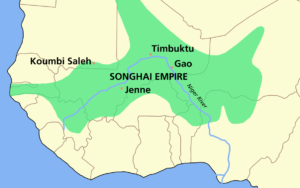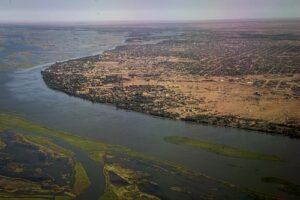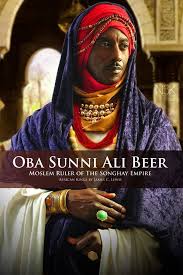The Songhai Empire was a kingdom that controlled the Western Sahel during the 15th and 16th centuries. It is also known as Songhay and was one of the greatest empires in African history.
The name was derived from the Songhai people and was made the leading ethnic group in the region. It was also known as the great trading state of West Africa.

Source: www.travelthruhistory.com
Where was the Songhai Empire Situated?
Songhai Empire was located in the South of the Sahara Desert along the Niger River. It was situated on the banks of the Niger River in the modern-day country of Mali.
Songhai people are said to have established themselves in the city of Gao for a long time before 800 AD. However, they did not regard it as their capital at first. Not until the beginning of the 11th century, during the reign of Dia (King) Kossoi.
The City of Gao in Songhai
The city of Gao was the capital city of the Songhai Empire. From 1325 to 1375, the rulers of Mali made it a part of their empire and expanded across West African Savanna.
Mali’s power eventually weakened and in the year 1335, the Dia (King) line of rulers gave way to the Sunnito rule. Suleiman-Mar, one of the Sunni is said to have won back Gao’s independence. Sunni Ali Sonni ruled Gao for 28 years and died in 1492.

Source: www.worldhistory.org
Songhai Under Emperor Sunni Ali.
Sunni Ali Ber, the military commander who took back the Gao city is known throughout history as the first great ruler of the Songhai Empire. He continued to conquer other Tans-Saharan trade routes and provinces of Mali.

Source: m.facebook.com
After Sunni Ali’s death in 1492, his son Sonni Baru assumed the throne as the emperor. But, he wasn’t his father, and soon lost the throne to Askia (Emperor) Muhammad Toure one year later.
Songhai Empire under Askia Muhammad

Source: www.alchetron.com
Muhammad continued to conquer other trade routes and expand his leadership throughout Mali. Being a devout Muslim, he centralized power in the state, established the Sharia law, and built lots of schools throughout the Songhai empire.
The Songhai empire comprised five provinces. These were headed by a governor each. All the governors, judges, and town leaders were Muslims under Askia Muhammad.
Askia Muhammad also strengthened the political and cultural ties with the other Muslim states and developed the economy of the empire. He was the first West African ruler to permit the exchange of ambassadors with other Muslim states.
Muhammad died in 1528, and until then, the Songhai empire enjoyed a period of peace and prosperity.
How did the Songhai Empire expand to a great kingdom?
Ali conquered Timbuktu and made it a part of the Songhai Empire. Sunni Ali went on to repulse a Mossi attack on Timbuktu. He also defeated the Dogon and Fulani people who had settled in the hills of Bandiagara. By doing so, in 1468, Ali had rid the empire of any immediate danger.
Timbuktu was the second strongest city, prospering tremendously in commerce. Conquering Timbuktu meant the prosperity of the entire city.
Ali also evicted the Tuareg from Timbuktu. The Tuareg had occupied the city since 1433. After a siege of seven years, Ali took Jenne (Djenné) and made it part of the empire. This occurred in 1473.
By 1476, the Songhai had dominated the lakes region. It is the area of the middle Niger to the west of Timbuktu.
Ali also repulsed a Mossi attack on Walata. This was in the northwest of the empire. It happened in the year 1480. Later, he discouraged raiding by all the inhabitants of the Niger valley’s southern border. All these were his method of fostering peace and freedom in the Songhai Empire.
Askia Muhammad Unique Reign
Askia had a strong influence as a leader of the Songhai Empire. With this power, he centralized bureaucracy and elected ministers and governors in different provinces. These ministers worked for him and reported complex subjects to him.
Due to the conquer of different states, the Songhai culture had become a mixture of customs and traditions. These were the traditional West African beliefs and Islamic religion. Traditions and local customs often governed daily life. However, the law of the land was solely based on Islam.
The vibrant trade in slaves was a significant part of the Songhai Empire. Slaves mostly aided the movement of goods. These goods were always carried into Morocco and the Middle East, across the Sahara Desert.
Askia Muhammad also traded in slaves throughout Europe and America. They were mostly taken for labor.
Generally, the energetic and able-bodied men taken as slaves in the Songhai Empire were mostly captured war prisoners. The neighboring areas provided these slaves, especially during raids in those areas. The emperor, governors, and town leaders benefited most from the slave trade.
What Led to the Fall of the Songhai Empire?
After Askia Muhammad’s death, internal conflicts and civil wars erupted in different parts of the empire. In 1591, the Moroccan Sultan, Ahmad I al-Mansur Saadi, saw this as an opportunity to attack and conquer the empire.
The Moroccan invaders had to face the last Songhai Emperor at the time, Askia Ishaq II. Although the Empire’s army outnumbered the invaders, they were still defeated due to the war tactics of the Moroccan army.
The Songhai Empire, although strong, retreated from the war when Askia Ishaq II was killed by the invaders.
The Moroccan Army soon realized that governing the Songhai Empire was a lot more difficult than conquering it. Constant rebellions and shortage of supplies forced the Moroccan invaders to send additional resources.
These logistics problems and the near impossibility of managing the goldmines in the Songhai Empire forced the troop to withdraw from the region in 1661.
After this, the Songhai Empire couldn’t be reestablished. The surviving citizens fled Gao and set up a new capital at Lulami. From 1591 to 1901, several Askias tried to rule the empire but the bond had already been broken.
French Colonies finally conquered the state in 1901 and sent the last of the Songhai to extinction.

